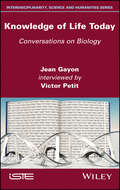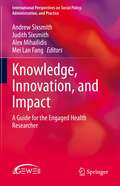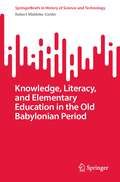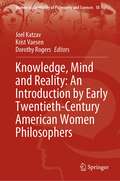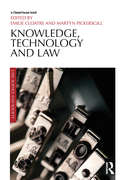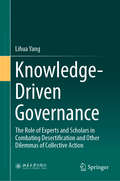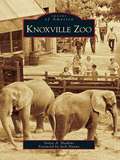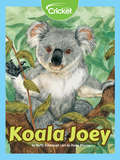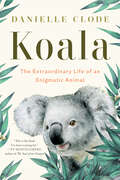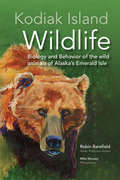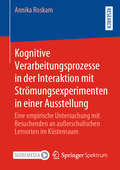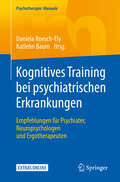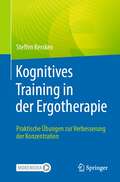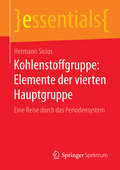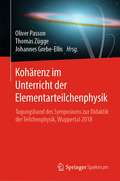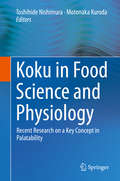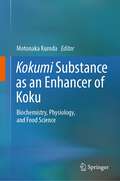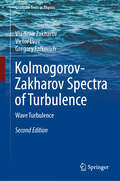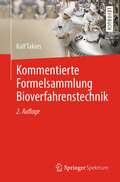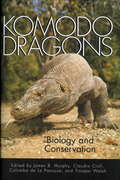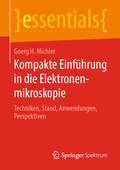- Table View
- List View
Knowledge of Life Today: Conversations on Biology (Jean Gayon interviewed by Victor Petit)
by Jean Gayon Victor PetitKnowledge of Life Today presents the thoughts of Jean Gayon, a major philosopher of science in France who is recognized across the Atlantic, especially for his work in philosophy and the history of life sciences. The book is structured around Gayon's personal answers to questions put forward by Victor Petit. This approach combines scientific rigor and risk-taking in answers that go back to the fundamentals of the subject.As well as the relationship between philosophy and the history of science, Gayon discusses the main questions of the history and philosophy of biology that marked his intellectual journey: Darwin, evolutionary biology, genetics and molecular biology, human evolution, and various aspects of the relationship between biology and society in contemporary times (racism, eugenics, biotechnology, biomedicine, etc.).
Knowledge, Innovation, and Impact: A Guide for the Engaged Health Researcher (International Perspectives on Social Policy, Administration, and Practice)
by Andrew Sixsmith Judith Sixsmith Alex Mihailidis Mei Lan FangThis book provides researchers with a straightforward and accessible guide for carrying out research that will help them to combine good science with real-world impact. The format of this book is simple: concise chapters on key topics, examples and case studies, written in plain language that will guide researchers through the process of research-driven innovation. The book draws on the editors’ experience in leading the Age-Well Network of Excellence. The aim of Age-Well is to drive innovation in the area of technology and aging. Researchers often lack the knowledge and abilities to commercialize or mobilize the outcomes of their research. Moreover, there is a lack of training and education resources suitable for the wide range of disciplines and experience that are becoming more typical. The book emphasizes the practicalities of “how to” undertake the kinds of activities that researchers should be engaging in if they are serious about achieving impact. Overall, this book will guide researchers through the process of research-driven innovation.
Knowledge, Literacy, and Elementary Education in the Old Babylonian Period (SpringerBriefs in History of Science and Technology)
by Robert Middeke-ConlinThis book examines education as a means to explore knowledge and literacy in the Old Babylonian period. It further employs a new method to research these topics. Contrary to numerous existing studies on the subject, the author examines elementary education globally, that is, in pursuit of Old Babylonian education in its entirety. Typically, education is examined in a piecemeal fashion. It's as if education centered on lexicography alone or mathematics alone. This work encompasses a view about educational content and knowledge systems, as opposed to only specific aspects or branches of them. In doing so, a characterization of institution and society is made possible allowing the work to open new general perspectives on Mesopotamian knowledge, literacy, and education.
Knowledge, Mind and Reality: An Introduction by Early Twentieth-Century American Women Philosophers (Women in the History of Philosophy and Sciences #18)
by Joel Katzav Krist Vaesen Dorothy RogersThis book is the first volume featuring the work of American women philosophers in the first half of the twentieth century. It provides selected papers authored by Mary Whiton Calkins, Grace Andrus de Laguna, Grace Neal Dolson, Marjorie Glicksman Grene, Marjorie Silliman Harris, Thelma Zemo Lavine, Marie Collins Swabey, Ellen Bliss Talbot, Dorothy Walsh and Margaret Floy Washburn. The book also provides the historical and philosophical background to their work. The papers focus on the nature of philosophy, knowledge, the philosophy of science, the mind-matter nexus, the nature of time, and the question of freedom and the individual. The material is suitable for scholars, researchers and advanced philosophy students interested in (history of) philosophy; theories of knowledge; philosophy of science; mind, and reality.
Knowledge, Technology and Law (Law, Science and Society)
by Martyn Pickersgill Emilie CloatreThe relationships between knowledge, technologies, and legal processes are central to the constitution of contemporary societies. As such, they have come to provide the focus for a range of academic projects, across interdisciplinary legal studies and the social sciences. The domains of medical law and ethics, intellectual property law, environmental law and criminal law are just some of those within which the pervasive place and ‘impact’ of technoscience is immediately apparent. At the same time, social scientists investigating the making of technology and expertise - in particular, scholars working within the tradition of science and technology studies - frequently interrogate how regulation and legal processes, and the making of knowledge and technologies, are intermingled in complex ways that come to shape and define each other. This book charts the important interface between studies of law, science and society, as explored from the perspectives of socio-legal studies and the increasingly influential field of science and technology studies. It brings together scholars from both areas to interrogate the joint roles of law and science in the construction and stabilization of socio-technical networks, objects, and standards, as well as their place in the production of contemporary social realities and subjectivities.
Knowledge-Driven Governance: The Role of Experts and Scholars in Combating Desertification and Other Dilemmas of Collective Action
by Lihua YangThis book explores a new model for addressing the central issue of environmental and other collective actions. An alternative to the classical models: central authority, privatization, and self-governance, it has provisionally been named “expert and scholar-based-” or “knowledge-driven governance”. The book also identifies seven working rules (or design principles) for successful knowledge-driven governance, and argues that the more strictly these rules are abided by, the more successful this model of governance becomes. Lastly, it demonstrates that in addition to Lindblom’s observed intellectually guided society and preference-guided/volition-guided society, there may be the possibility of a knowledge-driven society in which knowledge or intellect plays a greater role. The results obtained are supplemented by numerical calculations, presented as tables and figures. This book is intended for graduate students, lecturers and researchers working in environmental management, environmental science and engineering, sustainable development, collective action, and public administration.
Knoxville Zoo (Images of America)
by Jack Hanna Sonya A. HaskinsThe Knoxville Zoo began as the Birthday Park Zoo in 1948. Due to a lack of expertise and funding, the Humane Society started proceedings to close the zoo in 1971 after the animals' welfare came under scrutiny. The zoo was saved by Guy Smith, a local television executive, who took on the job as the zoo's first director at a salary of $1 per year. Smith managed to convince the City of Knoxville and the local community to invest in this wonderful sanctuary. As the zoo's conditions improved and awareness was raised, a focus was placed on breeding threatened or endangered animals. These efforts were rewarded in 1978 with the birth of the first two African elephants to be born in the western hemisphere. This book celebrates the zoo's fascinating history with approximately 200 black-and-white images and detailed captions of its birth, rebirth, and journey toward becoming one of the nation's premier zoological institutions. This is a keepsake that zoo visitors and wildlife enthusiasts alike will enjoy.
Knuckleboom Loaders Load Logs: A Trip to the Sawmill
by Steven Borns Joyce Slayton-MitchellIn Knuckleboom Loaders Load Logs, Joyce Slayton Mitchell takes readers on a trip from the woods to the sawmill. Huge saws, hi-tech feller bunchers, rugged knuckleboom loaders, and speedy slasher saws are just some of the fascinating machines that are used to turn trees into lumber, sawdust, wood chips, and many other useful materials. The superb full-color photographs by veteran photographer Steven Borns, and the author's straightforward descriptions, make it easy for armchair visitors to follow along as trees are felled and delimbed in the forest and then trucked to the sawmill where they are scaled, sorted, debarked, and sawn. Children will delight in scanning the crystal-clear pictures to imagine themselves operating each machine and figuring out which is doing what. A glossary of timber talk, a page of forest facts, and a list of forestry websites for children and teachers help readers young and old learn the lingo and understand more about trees -- our most important renewable natural resource.
Knuckleboom Loaders Load Logs: A Trip to the Sawmill
by Steven Borns Joyce Slayton-MitchellIn Knuckleboom Loaders Load Logs, Joyce Slayton Mitchell takes readers on a trip from the woods to the sawmill. Huge saws, hi-tech feller bunchers, rugged knuckleboom loaders, and speedy slasher saws are just some of the fascinating machines that are used to turn trees into lumber, sawdust, wood chips, and many other useful materials. The superb full-color photographs by veteran photographer Steven Borns, and the author's straightforward descriptions, make it easy for armchair visitors to follow along as trees are felled and delimbed in the forest and then trucked to the sawmill where they are scaled, sorted, debarked, and sawn. Children will delight in scanning the crystal-clear pictures to imagine themselves operating each machine and figuring out which is doing what. A glossary of timber talk, a page of forest facts, and a list of forestry websites for children and teachers help readers young and old learn the lingo and understand more about trees -- our most important renewable natural resource.
Koala Joey
by Buffy SilvermanDo you know what a baby koala, or a joey, looks like? Learn about how a joey spends its first year—from staying exclusively inside its mother's pouch, to venturing out into the world, and finally to moving into its own tree.
Koala: A Natural History And An Uncertain Future
by Danielle ClodeA New Scientist Best Popular Science Book of the Year "This is the book I’ve been waiting for." —Sy Montgomery, author of The Soul of an Octopus An Australian biologist delves into the extraordinary world of koalas, from their ancient ancestors to the current threats to their survival. Koalas regularly appeared in Australian biologist Danielle Clode’s backyard, but it was only when a bushfire threatened that she truly paid them attention. She soon realized how much she had to learn about these complex and mysterious animals. In vivid, descriptive prose, Clode embarks on a delightful and surprising journey through evolutionary biology, natural history, and ecology to understand where these enigmatic animals came from and what their future may hold. She begins her search with the fossils of ancient giant koalas, delving into why the modern koala has become the lone survivor of a once-diverse family of uniquely Australian marsupials. Koala investigates the remarkable physiology of these charismatic creatures. Born the size of tiny “jellybeans,” joeys face an uphill battle, from crawling into their mother’s pouch to being weaned onto a toxic diet of gum-tree leaves, the koalas’ single source of food. Clode explores the complex relationship and unexpected connections between this endearing species and humans. She explains how koalas are simultaneously threatened with extinction in some areas due to disease, climate change, and increasing wildfires, while overpopulating forests in other parts of the country. Deeply researched and filled with wonder, Koala is both a tender and inquisitive paean to a species unlike any other and a call to ensure its survival.
Kodeen liburua
by Simon SinghMilaka urtez, komunikazioaren eraginkortasuna izan dute ardatz errege-erreginek eta jeneralek beren herrialdeak gobernatzeko eta armadak zuzentzeko. Aldi berean, ondotxo zekiten zer ondorio zituzten beren mezuak esku okerretara iristeak, herrialde lehiakideei sekretu baliotsuak ezagutarazteak eta funtsezko informazioa etsaien esku uzteak. Mezuak etsaien eskuetara heltzeko arrisku eta mehatxuak bultzatu zuen garatzea kodeak eta zifrak: mezuak mozorrotzeko teknikak, dagokion hartzailea bakarrik izan dadin mezua irakurtzeko gai.<P><P> Sekretu-premiaren ondorioz, kodeak egiteaz arduratzen diren sailak sortu dituzte herrialdeek, eta sail horien ardura da ahalik eta koderik egokienak sortzea komunikazioen segurtasuna bermatzeko. Aldi berean, etsaien kode-hausleak kode horiek hausten eta, hala, sekretuak lapurtzen saiatu dira beti. Kode-hausleak hizkuntzaren alkimistak dira, esanahirik gabeko ikurretatik abiaturik esanahidun hitzak biltzeko gai den tribu mistikoa. Kode eta zifren historia kodegileen eta kode-hausleen arteko borroka zaharraren istorioa da, historiaren bilakaeran eragin berebizikoa izan duen arma intelektualen lehia.<P> Kodeen liburua idaztean, bi helburu nagusi izan ditut. Lehenengoa, kodeen eboluzioa deskribatzea. Eboluzioa termino egokia da, bai, kodeen garapena borroka ebolutibo gisa ikus baitaiteke. Kode batek kode-hausleen erasoak jasaten ditu beti. Kode-hausleek kode baten ahultasuna agerian uzten duen arma berriren bat garatzen dutenean, balioa galtzen du kode horrek. Desagertu egiten da, edo kode berri indartsuago bihurtzen. Era berean, kode berri horrek kode-hausleek haren ahulezia aurkitu arte bakarrik balioko du; eta horrela behin eta berriz. Bakterio baten andui infekzioso batekin gertatzen denaren antzekoa da. Bakterioak bizi eta hazi egiten dira, harik eta medikuek bakterioaren ahulezia agerian utzi eta hiltzen dituen antibiotiko bat aurkitzen duten arte. Bakterioek, orduan, eboluzionatu egin behar izaten dute, eta antibiotikoa engainatzen saiatu; eta, hori lortzen badute, aurrera egiten dute, eta berriz zabaltzen dira. Bakterioek eboluzionatu egin behar dute etengabe, antibiotiko berrien sarraskiari ihes egingo badiote.
Kodiak Island Wildlife: Biology and Behavior of the wild animals of Alaska's Emerald Isle
by Robin BarefieldKodiak Island, nicknamed the Emerald Isle, gleams like a gem in the North Pacific. Lush green mountains soar skyward from the ocean, framing deep, fjord-like bays. The island's wet maritime climate and mild temperatures encourage thick vegetation growth, which provides sustenance for the abundant wildlife on the island. The Alaska Current flows northward near Kodiak, bringing warm water and nutrients to Alaska's frigid Gulf. These nutrients form the basis for one of the richest marine ecosystems in the world. Kodiak bears reign as the island's monarchs, which has among the densest brown bear populations on earth. They are one of the six endemic mammals found on Kodiak, while humans have introduced many other wild mammals to the Kodiak Archipelago. The ocean surrounding Kodiak teems with seals, sea otters, sea lions, porpoises, and whales, while bald eagles, puffins, rare black oystercatchers, and arctic terns (which migrate all the way from Antarctica) also call the archipelago home. Learn more about this beautiful North Pacific gem and its amazing wildlife—and the challenges the animals face, both human and natural—in this richly detailed book by local naturalist, wildlife biologist, and sportfishing guide Robin Barefield, with photographs by her husband, Mike Munsey.
Kognitive Verarbeitungsprozesse in der Interaktion mit Strömungsexperimenten in einer Ausstellung: Eine empirische Untersuchung mit Besuchenden an außerschulischen Lernorten im Küstenraum
by Annika RoskamDer Küstenraum ist ein dynamisches System, welches sensibel auf Veränderungen reagiert. Aufgrund der hohen Dynamik ist das Wattenmeer 2009 zum UNESCO Weltnaturerbe ernannt worden. Um diese besondere Bedeutung auch in außerschulischen Lernorten zu vermitteln, wird eine Ausstellung zu Strömungsphänomenen konzipiert und erprobt. Dabei werden kognitive Verarbeitungsprozesse von Besuchenden in der Interaktion mit Experimenten zu Strömungsphänomenen untersucht. Im Sinne des Design-based Research werden Weiterentwicklungen und Generalisierungen herausgearbeitet. Die Ergebnisse der empirischen Untersuchung sind in dieser Arbeit dargestellt, insbesondere werden Leitlinien für die Konzeption bzw. Weiterentwicklung von interaktiven Ausstellungen abgeleitet.
Kognitives Training bei psychiatrischen Erkrankungen: Empfehlungen für Psychiater, Neuropsychologen und Ergotherapeuten (Psychotherapie: Manuale)
by Daniela Roesch-Ely Katlehn BaumZahlreiche psychiatrische Erkrankungen gehen mit kognitiven Störungen einher, die die Alltagsfunktionalität der Patienten teils erheblich einschränken. In diesem Buch geben die Herausgeberinnen einen Überblick über kognitive Störungen bei ausgewählten Erkrankungen wie Schizophrenie, affektiven Erkrankungen, adultem ADHS und Autismus-Spektrum-Störungen und präsentieren praxisnahe Empfehlungen zu Planung, Struktur und praktischer Umsetzung entsprechender kognitiver Trainingsprogramme. Abgerundet wird das Manual durch entsprechende Fallbeispiele sowie verschiedene Informations- und Arbeitsblätter, die zum Download zur Verfügung stehen.Dieses Manual entstand in der Psychiatrischen Ambulanz für Kognitives Training (PAKT) des Universitätsklinikums Heidelberg und richtet sich an Psychiater, Neuropsychologen und Ergotherapeuten, die Patienten mit psychiatrischen Erkrankungen und assoziierten kognitiven Defiziten behandeln.
Kognitives Training in der Ergotherapie: Praktische Übungen zur Verbesserung der Konzentration
by Steffen KerskenDieses Praxisbuch liefert alles Wesentliche für das kognitive Training in der Ergotherapie. Welche Assessments sind zur Erfassung der Hirnleistung sinnvoll? Eignet sich eine ergotherapeutische Übung zur Förderung von Konzentration? Wie kann ich meine Patient*innen hinsichtlich Problemlösungs- und Entscheidungsfähigkeit unterstützen? Hier finden Sie die Antworten zu allen Aspekten des Hirnleistungstrainings. Aus dem Inhalt: Kreative und handlungsorientierte Übungen auf Basis eines sechssäuligen Therapiekonzeptes, Berufsbelastungsübungen, Präsentationen und Arbeitsstrategien, Förderung von Konzentration, Belastbarkeit und Aufmerksamkeit, Pausen- und Energiemanagement, Stressbewältigung mit zusätzlichen Arbeitsblättern zum Download.Gönnen Sie sich und Ihren Patient*innen etwas Abwechslung und bereichern Sie Ihr Behandlungsrepertoire um eine Vielzahl von kreativen Übungen.
Kohlenstoffgruppe: Eine Reise durch das Periodensystem (essentials)
by Hermann SiciusHermann Sicius zeigt dem Leser die sehr unterschiedlichen Gesichter der Elemente der Kohlenstoffgruppe (vierte Hauptgruppe). Kohle ist seit vorgeschichtlicher Zeit bekannt, und Diamant als zweite wichtige Modifikation des Nichtmetalls Kohlenstoff neben Graphit ist bereits in chinesischen Quellen aus dem dritten Jahrtausend vor Christus erwähnt. Seit der Bronzezeit kennen die Menschen das Metall Blei, und auch Zinn ist seit 5. 000 Jahren bekannt. Dass dem Sand das Element Silicium zugrunde liegt, wissen wir aber erst seit zwei Jahrhunderten, und Germanium wurde auch erst 1886 beschrieben. Flerovium - möglicherweise ein leicht flüchtiges Halbedelmetall - konnte noch gegen Ende des letzten Jahrtausends, im Jahr 1999, dargestellt werden. Reisen Sie mit uns durch diese Hauptgruppe; sie umfasst viel mehr als Kohlendioxid und Mennige.
Kohärenz im Unterricht der Elementarteilchenphysik: Tagungsband des Symposiums zur Didaktik der Teilchenphysik, Wuppertal 2018
by Oliver Passon Thomas Zügge Johannes Grebe-EllisKohärenz im Unterricht der ElementarteilchenphysikDas vorliegende Buch fasst die Ergebnisse des Symposiums „Kohärenz im Unterricht der Elementarteilchenphysik“ zusammen, das von der Arbeitsgruppe Physik und ihre Didaktik der Bergischen Universität Wuppertal veranstaltet wurde. Ziel des Treffens war ein Austausch zwischen Fachwissenschaft, der zugehörigen Fachdidaktik und den Bildungswissenschaften über verschiedene Möglichkeiten zur Vermittlung der Teilchenphysik im Schulunterricht.Den Inhalt des vorliegenden Buches bilden die Beiträge, die von den Beteiligten im Anschluss an das Symposium ausgearbeitet wurden. Die Diskussionen im Anschluss zu den Vorträgen sind jedem Beitrag als jeweils letztes Unterkapitel hinzugefügt.Aus dem Inhalt· Quarks und Feynman-Diagramme: Basiswissen im Schulunterricht? – Wolfgang Wagner· Erzeugung und Vernichtung von Teilchen – Robert Harlander· Teilchen und Wellen als kosmische Boten – Brigitte Falkenburg· Mit moderner Physik zum mündigen Bürger – Thomas Zügge· Mystifizierung der Quantenmechanik und Trivialisierung der Teilchenphysik – Oliver Passon· Basiskonzepte des Standardmodells für die Schule – Michael Kobel und Philipp Lindenau· Das CERN-Schülerlabor S’Cool LAB – Julia Woithe et al.· Das Wuppertaler Curriculum der Elementarteilchenphysik – Thomas Zügge und Oliver Passon Die HerausgeberOliver Passon ist Akademischer Oberrat in der Arbeitsgruppe Physik und ihre Didaktik an der Bergischen Universität Wuppertal. Sein Hauptarbeitsgebiet ist die Didaktik und Philosophie der modernen Physik.Thomas Zügge ist Diplom-Physiker und seit 2016 Doktorand in der Arbeitsgruppe Physik und ihre Didaktik an der Bergischen Universität Wuppertal. Seine Dissertation wird die Rolle von Vermittlungskontexten im Physikunterricht behandeln.Johannes Grebe-Ellis ist Universitätsprofessor für Physik und ihre Didaktik an der Bergischen Universität Wuppertal. Er entwickelt phänomenologische Zugänge zur Physik und ist Herausgeber der Schriftenreihe „Phänomenologie in der Naturwissenschaft“.
Koku in Food Science and Physiology: Recent Research on a Key Concept in Palatability
by Toshihide Nishimura Motonaka KurodaThis is the first book to explore the science underlying the concept of “koku”, which is central to an understanding of the palatability of food within Japanese cuisine and is attracting increasing interest among food scientists and professionals worldwide. Koku may be defined as the sensation that results from the complexity of the food (i.e., its richness or body), its lingering aftertaste or persistence, and its heartiness in terms of taste, aroma, and texture. A variety of substances have been found to impact significantly on koku, including umami substances, phytosterols, certain aromatic compounds, and kokumi substances. In Koku – Food Science and Physiology, readers will find full explanation of the conceptual aspects and the latest research results on a wide range of topics, including the relevant flavor chemistry and sensory analysis. Written by leading scientists in the field, the book will be a valuable resource for students and researchers in the fields of food chemistry, nutritional science, taste physiology, and neuroscience, as well as for professionals in the food industry.
Kokumi Substance as an Enhancer of Koku: Biochemistry, Physiology, and Food Science
by Motonaka KurodaThis book provides the basic concepts and latest findings on kokumi substances. It covers not only the topics related to food chemistry, but also the biochemical and physiological mechanisms of the perception of kokumi substances. Food palatability is determined by many factors, including taste, aroma, texture, color, physiological condition, and circumstances. The attribute called “koku” is used in Japan to express delicious foods. The definition of koku attribute was previously proposed to be caused by the sensation of richness, body, lingering (continuity), and mouthfulness in terms of taste, aroma, and texture. Kokumi substance is one of the taste-related koku enhancers and is defined as a substance that enhances complexity, richness (body), and lastingness (continuity), although it has no taste itself at the dose. The topics in this book cover physiological studies, including the receptor mechanism, taste nerve recording, and human brain responses using functional MRI. It also discusses the sensory characteristics of kokumi substances when added to foods and the effect of kokumi substances on the satiety. The intended readers are university students, researchers and technologists in food science, food chemistry, nutritional sciences, taste physiology, and neuroscience. Non-expert readers interested in food palatability and the deliciousness of foods may also find this book useful.
Kolmogorov-Zakharov Spectra of Turbulence: Wave Turbulence (Graduate Texts in Physics)
by Gregory Falkovich Vladimir Zakharov Victor LvovStarting at the level of graduate students, this book offers a comprehensive introduction to a rapidly developing field of turbulence. It also presents the state of the art of the theory of wave turbulence in diverse media for researchers looking for a formalism to solve existing problems or for new research subjects and ideas. The book provides a general theory of developed wave turbulence in different media: plasmas, solids, atmosphere, oceans and space. The presentation starts with a simple and intuitive dimensional analysis and proceeds to a rigorous analytic theory with exact solutions for the stationary spectra of turbulence, stability theory of such spectra, description of nonstationary regimes and matching spectra with pumping and dissipation regions. The reader is provided with the necessary tools to study nonlinear waves and turbulence: Hamiltonian formalism, statistical description, derivation of kinetics equations and methods of finding their steady and non-steady solutions. In this second edition the book is brought up to date both in theoretical and experimental/observational aspects. In particular, the authors have updated and revised the description of nonstationary turbulence, turbulent entropy production, etc, and added discussions of master equation and several cases of strong turbulence and nonlocal cascades. The book now includes excercises, some with solutions.
Kommentierte Formelsammlung Bioverfahrenstechnik
by Ralf TakorsDie kommentierte Formelsammlung bietet einen schnellen und umfassenden Überblick über unterschiedlichste Aspekte der Bioverfahrenstechnik, wie zum Beispiel wichtige chemische Gleichungen, Enzymkinetiken oder Stoff- und Wärmetransporte, um nur einige wenige Themen zu nennen. Darüber hinaus wird die Entwicklungskette von ersten Laborversuchen bis hin zum Scale-up und der wirtschaftlichen Analyse entsprechender Prozesse für Leser übersichtlich zusammengefasst. In der neuen 2. Auflage sind neben inhaltlichen Erweiterungen der oben genannten Themen auch Stoffwechselschemata Industrie-relevanter Mikroorganismen und Säugerzellen zusammengestellt, die für Produktionszwecke eingesetzt werden. Motiviert durch eigene Erfahrungen im akademischen und industriellen Bereich wurde dieses kleine Nachschlagewerk erstellt. Es soll denjenigen, die mit unterschiedlichen Aufgaben in der Forschung und Entwicklung betraut sind, als schnell verfügbare Quelle zur Problemlösung zur Verfügung stehen. Darüber hinaus kann es auch Studierenden als Leitfaden für die Ausbildung im Bereich Bioverfahrenstechnik dienen.
Komodo Dragons
by James B. Murphy Colomba de La Panouse Claudio Ciofi Trooper WalshMore than twenty years have passed since Walter Auffenberg's monumental The Behavioral Ecology of the Komodo Monitor. In the intervening years the populations of Komodo dragons--native only to a handful of islands in southeast Indonesia--have dwindled, sparking intensive conservation efforts. During the last two decades new information about these formidable predators has emerged, and the most important findings are clearly presented here.A memoir from Walter Auffenberg and his son Kurt is followed by the latest information on Komodo dragon biology, ecology, population distribution, and behavior. The second part of the book is dedicated to step-by-step management and conservation techniques, both for wild and captive dragons. This successful model is a useful template for the conservation of other endangered species as well, for, as Kurt and Walter Auffenberg note, "The species may well indeed survive in the wild for generations to come while countless other organisms are lost."
Komodo Dragons (Nature's Children)
by Geoff MillerCan Komodo dragons breathe fire? How many teeth do Komodo dragons have? What do young Komodo dragons look like? Find the answers to these questions, and learn much more about the physical characteristics, behavior, habitat, and lives of Komodo dragons. Other books in this series are available in this library.
Kompakte Einführung in die Elektronenmikroskopie: Techniken, Stand, Anwendungen, Perspektiven (essentials)
by Goerg H. MichlerGoerg Michler fasst das große Gebiet der Elektronenmikroskopie zusammen und stellt die verschiedenen Techniken übersichtlich dar. Der Autor beschreibt anschaulich die Einsatzmöglichkeiten der Mikroskopie und die Anforderungen an eine Probenpräparation. Mit Bildbeispielen aus der Praxis illustriert er die Darstellungen.Der Autor: Prof. Dr. rer. nat. habil. Goerg H. Michler war Leiter des Instituts für Werkstoffwissenschaften an der Martin-Luther-Universität Halle-Wittenberg, ist Ehrenvorsitzender des Instituts für Polymerwerkstoffe e.V. und Vorsitzender der Heinz-Bethge-Stiftung für angewandte Elektronenmikroskopie.
